
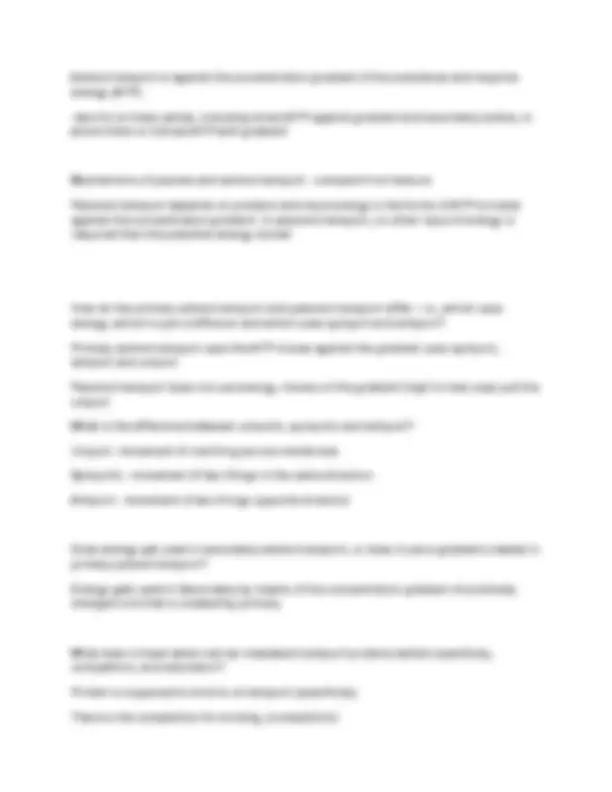
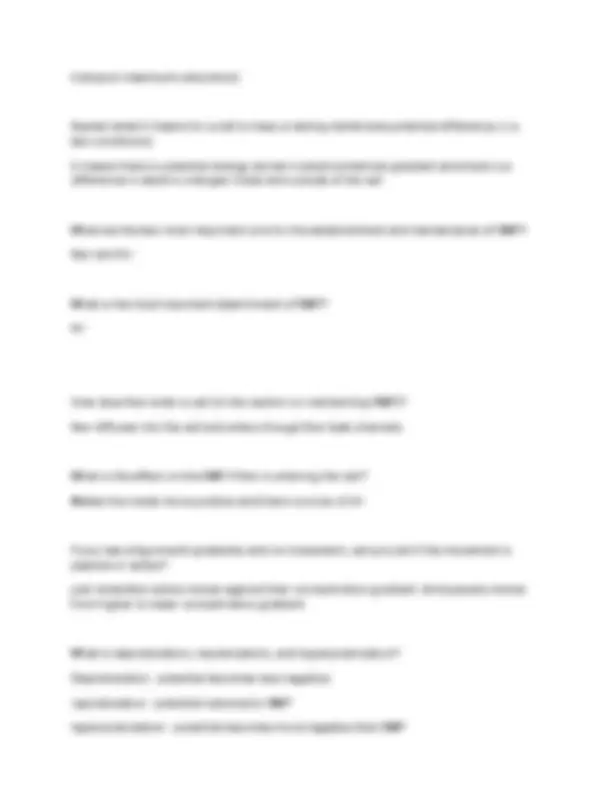
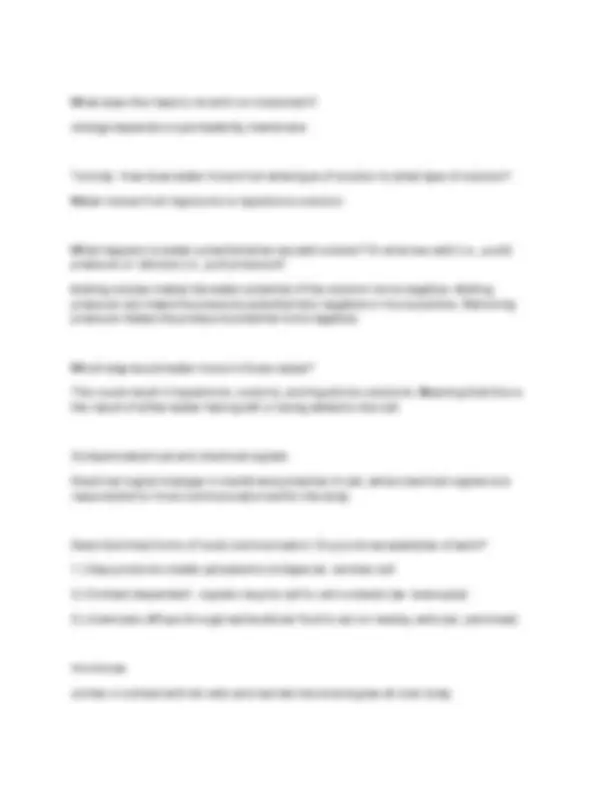
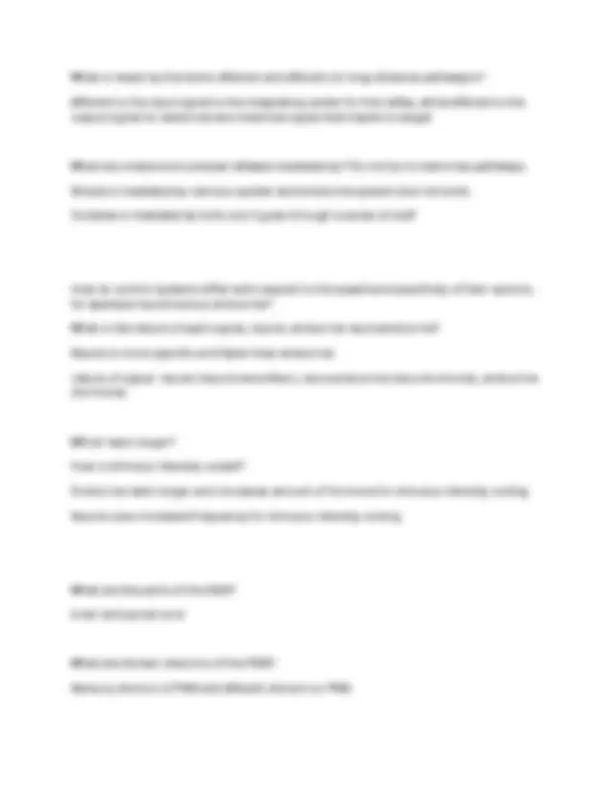
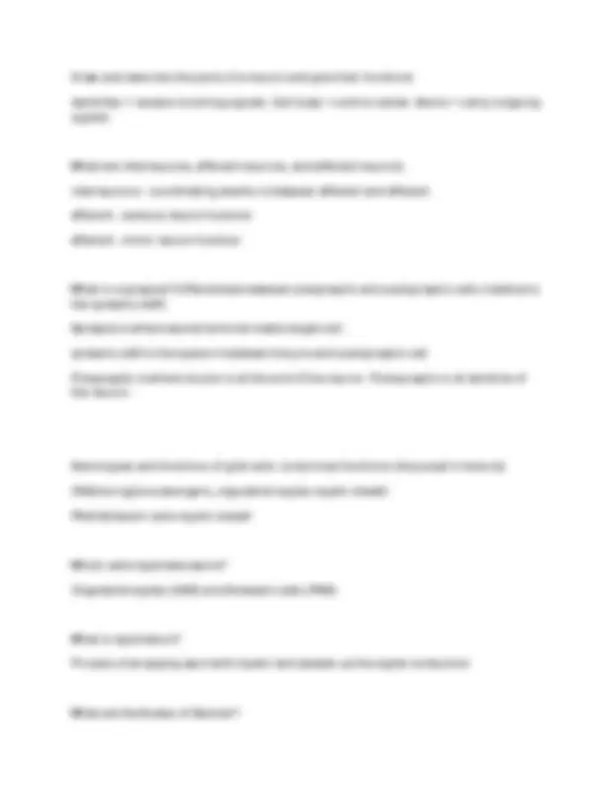
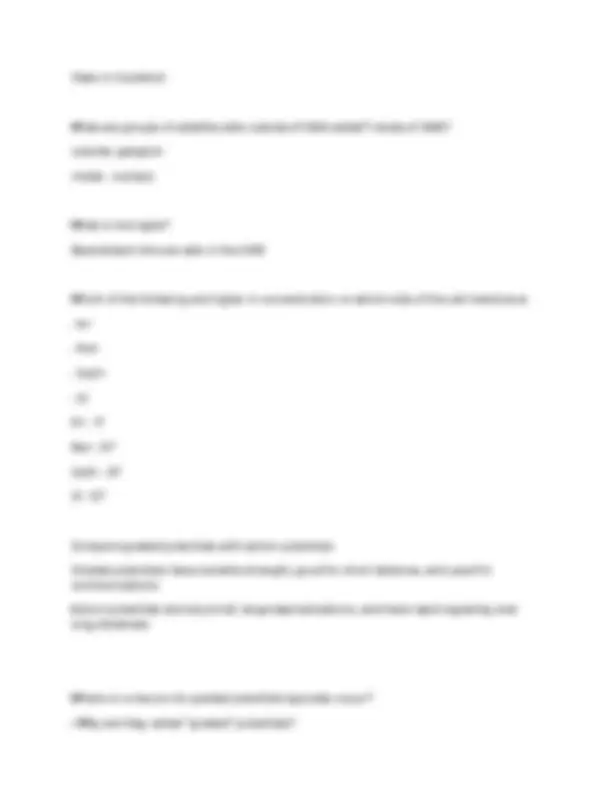
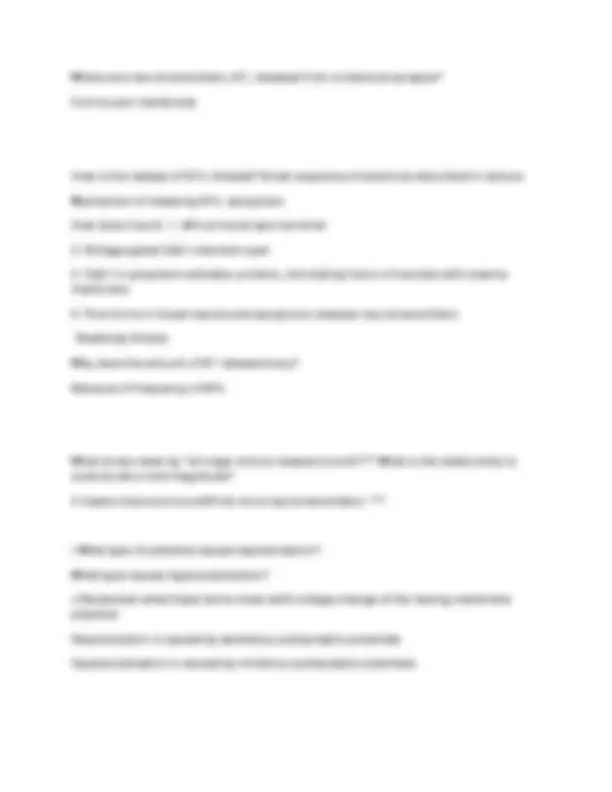
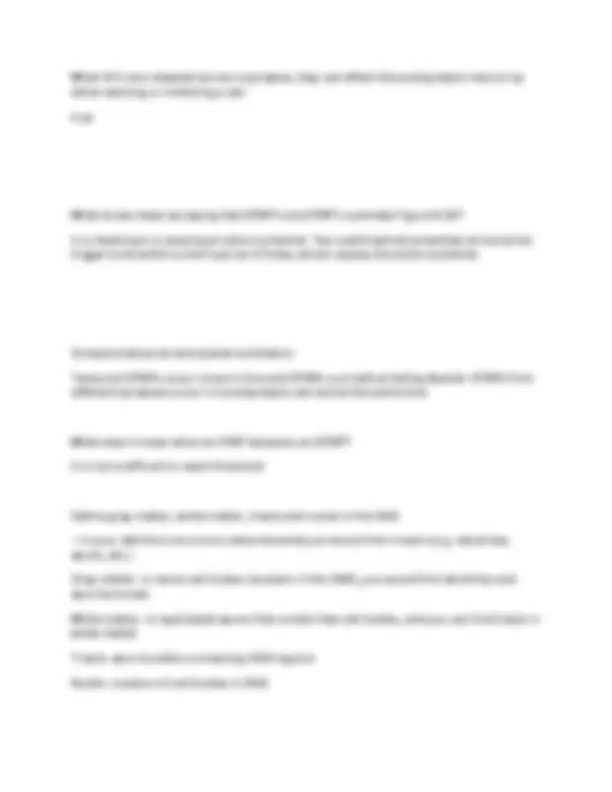
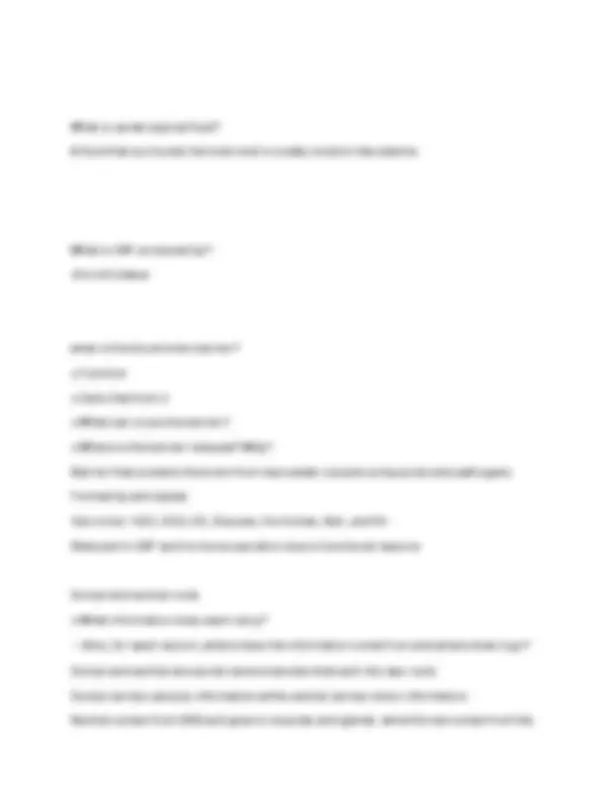
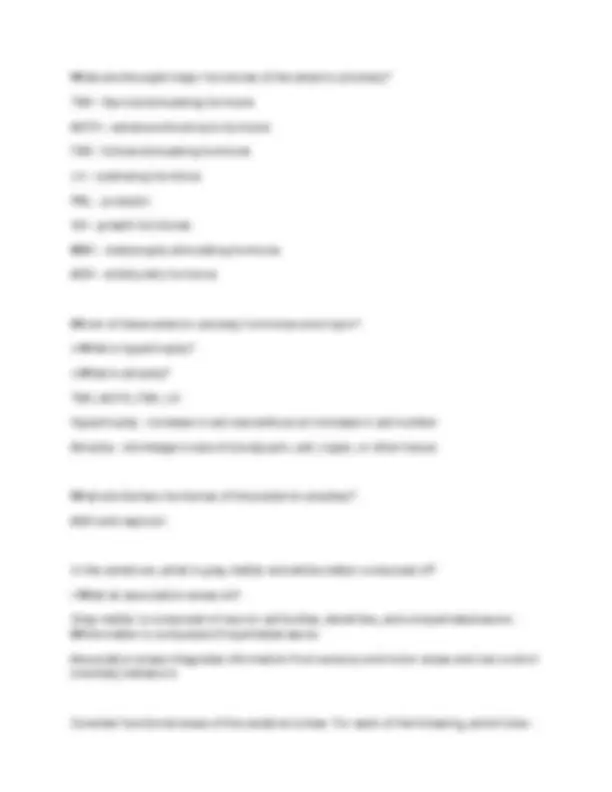
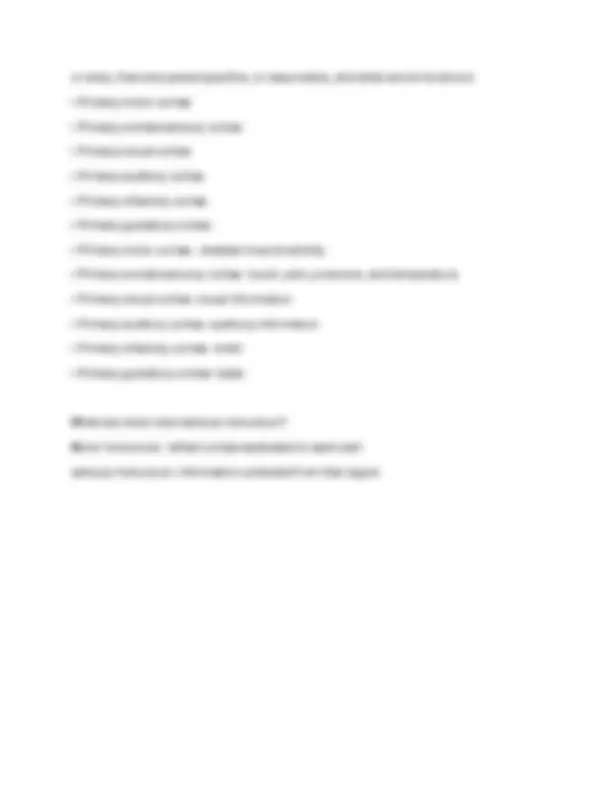


Study with the several resources on Docsity

Earn points by helping other students or get them with a premium plan


Prepare for your exams
Study with the several resources on Docsity

Earn points to download
Earn points by helping other students or get them with a premium plan
Community
Ask the community for help and clear up your study doubts
Discover the best universities in your country according to Docsity users
Free resources
Download our free guides on studying techniques, anxiety management strategies, and thesis advice from Docsity tutors
A comprehensive set of questions and answers related to cell membrane transport, covering key concepts such as passive and active transport, diffusion, osmosis, membrane potential, and signal transduction. It is a valuable resource for students studying cell biology or related fields.
Typology: Exams
1 / 19

This page cannot be seen from the preview
Don't miss anything!












Determine if a substance can cross a cell membrane - based on size or lipid solubility information Substance can pass across cell membrane if: particle is small, non-polar, in liquid solution can't : large molecule and charged atoms/molecules What must be present for the transport of substances to happen across a membrane? permeability of membrane and a driving force What are two major divisions of membrane transport? Active and passive
Can you list the forms of transport under each type? Active - vesicular transport ATP Passive - simple diffusion concentration gradient
What factors will influence the rates of diffusion? Magnitude, temperature, Permeability, and surface area
How would osmotic pressure vary with altering solute concentration? Increased solute concentration = Increased osmotic pressure Decreased solute concentration = Decreased osmotic pressure.
Be able to compare the osmolarities of two solutions Hypoosmotic - below, and less solute, more water Isosmotic - same Hyperosmotic - above (when thinking of osmotic it is ratio to solute)
Describe how water would move in hypotonic, hypertonic, and isotonic solutions Isotonic - no net movement of water Hypotonic - water enters cell Hypertonic - water leaves cells
Know the forces, i.e., gradient, etc. that cause water and solutes to move across membranes passively, i.e., without energy. movement of water w/o energy is caused by conc gradients, osmotic pressure, and membrane permeability.
Explain the difference between substances that are transported by simple diffusion and by facilitated diffusion. Substances transported in simple require no energy, goes down concentration gradient, which means from high to low Facilitated substances require no energy, but uses proteins
Describe how the magnitude of a gradient, permeability, temperature, and surface area influence the rate of diffusion Temperature - increase temperature = increase diffusion rate Gradient magnitude - increase gradient = increase in rate of diffusion Surface area - Increase surface area = increase in rate of diffusion Permeability - Increased permeability = increase in rate of diffusion In channel-mediated diffusion, name the types that are continuously open or open upon stimulus (i.e., name stimulus). continuously open is leak channels open on stimuli is gated channel the stimuli is ligands Know the mechanisms by which substances are moved across membranes against a concentration gradient (actively, with energy)
transport maximum( saturation)
Explain what it means for a cell to have a resting membrane potential difference; (i.e. two conditions) It means there is potential energy stored in electrochemical gradient and there is a difference in electric charges inside and outside of the cell
What are the two most important ions for the establishment and maintenance of RMP? Na+ and K+
What is the most important determinant of RMP? K+
How does Na+ enter a cell (in the section on maintaining RMP)? Na+ diffuses into the cell and enters though Na+ leak channels
What is the affect on the RMP if Na+ is entering the cell? Makes the inside more positive and there is a loss of K+
If you see a figure with gradients and ion movement, can you tell if the movement is passive or active? just remember active moves against their concentration gradient. And passive moves from higher to lower concentration gradient
What is depolarization, repolarization, and hyperpolarization? Depolarization - potential becomes less negative repolarization - potential restored to RMP hyperpolarization - potential becomes more negative than RMP
What does this have to do with ion movement? change depends on permeability membrane
Tonicity: How does water move from what type of solution to what type of solution? Water moves from hypotonic to hypertonic solution
What happens to water potential when we add solutes? Or when we add (i.e., push) pressure or remove (i.e., pull) pressure? Adding solutes makes the water potential of the solution more negative. Adding pressure can make the pressure potential less negative or more positive. Removing pressure makes the pressure potential more negative.
Which way would water move in those cases? This could result in hypertonic, isotonic, and hypotonic solutions. Meaning that this is the result of either water having left or being added to the cell.
Compare electrical and chemical signals Electrical signal changes in membrane potential of cell, while chemical signals are responsible for most communication within the body
Describe three forms of local communication. Do you know examples of each? 1.) Gap junctions-create cytoplasmic bridges ex: cardiac cell 2.) Contact-dependent - signals require cell to cell contacts (ex: leukocyte) 3.) chemicals diffuse through extracellular fluid to act on nearby cells (ex: pancreas)
Hormones comes in contact with all cells and secrets blood and goes all over body
The rapid signal pathways change ion flow through channels and that will cause a rapid flow of ions in or out of the cell, which in turn makes the cell have a rapid response.
What is the most important intracellular signal? Calcium
What is the difference between these gated channels? Voltage, Ligand, Mechanical Voltage - can be opened directly with a change in membrane potential Ligand - binds to the G protein receptor, which opens or closes the channel Mechanical - gated channels open with pressure or stretch on the cell membrane
Describe whether gases are long-acting or short-acting. Which one is the best known? What action does it have? Long acting, because it signal molecules that act close to where they are produced. best know : Nitric Oxide (NO) it diffuse into smooth muscle
What is an agonist and an antagonist? agonist- molecules that activate receptors antagonist- molecules that block receptors
About homeostatic reflex pathways describe tonic and antagonistic control. Which is up/down regulation? Which drives parameters in opposite directions? Tonic control, is pain and it is an up/down fashion regulation, always there but changing in intensity. Antagonistic control uses different signals and sends parameters in opposite directions
What is meant by the terms afferent and efferent (in long-distance pathways)? Afferent is the input signal to the integrating center for the reflex, while efferent is the output signal for electrical and chemical signal that travels to target
What are simple and complex reflexes mediated by? Do not try to memorize pathways. Simple is mediated by nervous system and endocrine system (but not both) Complex is mediated by both, but it goes through a series of stuff
How do control systems differ with respect to the speed and specificity of their actions, for example neural versus endocrine? What is the nature of each signal, neural, endocrine neuroendocrine? Neural is more specific and faster than endocrine. nature of signal: neural (neurotransmitter), neuroendocrine (neurohormone), endocrine (hormone)
Which lasts longer? How is stimulus intensity coded? Endocrine lasts longer and increases amount of hormone for stimulus intensity coding Neural uses increased frequency for stimulus intensity coding
What are the parts of the CNS? brain and spinal cord
What are the two divisions of the PNS? Sensory division of PNS and efferent division on PNS
Gaps in insulation
What are groups of satellite cells outside of CNS called? Inside of CNS? outside- ganglion inside - nucleus
What is microglia? Specialized immune cells in the CNS
Which of the following are higher in concentration on which side of the cell membrane:
Compare graded potentials with action potentials Graded potentials have variable strength, good for short distance, and used for communications Action potentials are very brief, large depolarizations, and have rapid signaling over long distances
Where on a neuron do graded potentials typically occur?
- Why are they called "graded" potentials?
- Why do graded potentials decay? Graded potential typically occurs on the dendrites. Graded potentials are called "graded" because their amplitude is variable and depends on the intensity of the stimulus action. Graded potentials decay because of current leak (ions crossing membrane)
What is a cell's excitability? the capability of firing an action potential
Where, on a neuron, do action potentials occur?
- Where do they originate? Occur at the axon hillock of a neuron They originate from the previous synaptic cleft
What is meant by "action potentials are all-ornone"? o If they are all or none, how can we perceive different stimulation intensities? By all or none, it means that once the threshold is reached, an action potential will fire regardless of the strength of the stimulus that initiated it. We can perceive an increase in stimulation intensities through frequency, recruitment of neurons, graded potentials, and different pathways and receptors
Be able to describe in detail, the events occurring in an action potential. To help you do this you might draw diagrams of each step and a plot showing the change in membrane potential (mV) over time. Figure 8. 1.) RMP 2.) Depolarizing stimulus 3.) Depolarizes to threshold Voltage-gated Na+ channels open 4.) Rapid Na+ entry depolarizes cell 5.) Na+ channels close and K+ channels open 6.) K+ moves outward 7.) K+ channels remain open hyperpolarizes cell 8.) Voltage-gated K+ channels close 9.) Cell returns to RMP
Where are neurotransmitters, NT, released from a chemical synapse? from bouton membrane
How is the release of NTs initiated? Know sequence of events as described in lecture Mechanism of releasing NTs: exocytosis How does it work: 1. APs arrive at axon terminal
What do we mean by "stronger stimuli release more NT?" What is the relationship to code duration and magnitude? It means there are more APs & more neurotransmitters. ***
- What type of potential causes depolarization? What type causes hyperpolarization? o Remember what these terms mean w/r/t voltage change of the resting membrane potential Depolarization is caused by excitatory postsynaptic potentials Hyperpolarization is caused by inhibitory postsynaptic potentials
When NTs are released across a synapse, they can affect the postsynaptic neuron by either exciting or inhibiting a cell. true
What do we mean by saying that EPSP's and IPSP's summate Figure 8.24? It is meaning it is causing an action potential. Two subthreshold potentials arrive at the trigger zone within a short period of times, which causes the action potential
Compare temporal and spatial summation Temporal-EPSPs occur close in time and EPSPs sum before fading Spatial- EPSPs from different synapses occur on postsynaptic cell and at the same time
What does it mean when an IPSP dampens an EPSP? It is more difficult to reach threshold
Define gray matter, white matter, tracts and nuclei in the CNS .• In your definition be sure to describe what you woul d find in each (e.g. dendrites, axons, etc.) Gray matter- is nerve cell bodies (clusters in the CNS), you would find dendrites and axon terminals White matter- is myelinated axons that contain few cell bodies, and you can find tracts in white matter Tracts- axon bundles connecting CNS regions Nuclei- clusters of cell bodies in CNS
PNS and goes to the lower part of the brain Gray Matter = Dorsal, lateral and ventral horns o What nuclei are represented in each? Dorsal = visceral and somatic sensory Lateral = visceral motor Ventral = somatic motor anterior
White Matter o What two tracts is present? ▪ What type of information does each carry?
▪ Be able to identify these tracts on a cross-section of the spinal cord (e.g. Figure 9.6) Ascending carrying sensory information and descending carrying motor signals
What is a reflex arc? Involuntary response to an external stimulus. Direct connection between sensory and motor neuron without connection to brain Ex: if you are to touch something hot you have an instant reflex
What is the function of the pyramids in the medulla?
- What does decussation mean? Carry motor axons from brain to spinal cords Decussation means crossing over
What is the function of the pons and midbrain?
Pons is the relay station and coordinates control of breathing, while midbrain is eye movement and relay signals for hearing and seeing reflexes
What is the function of the cerebellum?
- Proprioception Function: process sensory information and coordinate execution of movement. Proprioception is awareness of space in the cerebellum
What does the thalamus achieve? Is the relay station and all senses besides smell goes through the thalamus
What does the hypothalamus do? o What do tropic hormones do? ▪ What is their target? Hypothalamus controls homeostasis and is the center for behavioral drives. Tropic hormones releases inhibiting hormones and target is anterior pituitary hormones
What does the pineal gland do? secretes melatonin and controls sleep-wake cycle
The pituitary is divided into two lobes. o What are they? o How are they different? Anterior-which is nonneural endocrine cells Posterior- contains neurosecretory nerve endings from hypothalamus
or area, if we discussed specifics, is responsible, and what are its functions:
**- Primary motor cortex
What are motor and sensory homunculi? Motor homunculi- reflect cortex dedicated to each part sensory homunculi- information collected from that region